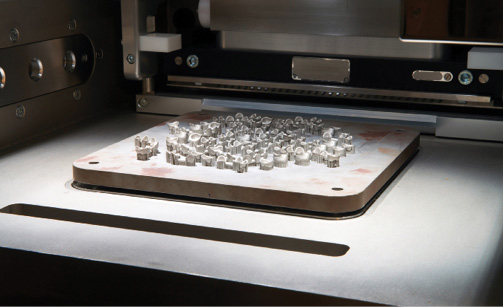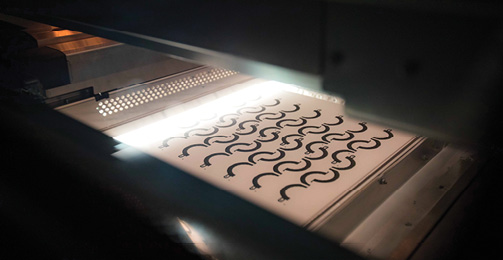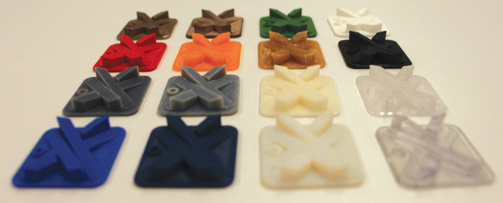(Finding) the Right Stuff
Impressed with all the cool shapes you can build on a 3D printer? What’s even more cool are all the different materials you can use to make them.

Remanufacturing a legacy pilot knob led to TOUGH-GRY 10, a high-speed ABS-like material for production applications. Image courtesy of 3D Systems.
Latest News
October 1, 2019
Designers and engineers have been going gaga over additive manufacturing’s (AM) seemingly unlimited design freedom since the day 3D Systems’ Chuck Hull sold his first 3D printer, the SLA-1. That was three decades ago, and although AM continues to impress us with its capabilities, it’s only over the past few years that 3D printing’s true potential—the ability to print advanced, often completely new materials—has come to light.
Imagine polymers able to change their properties or even shape in response to electrical signals and other external stimuli. How about metal polymer and carbon fiber composites, or printable elastic resins, or super-hard, heat-resistant ceramics, able to open various design doors?
“There are many notable innovations across the world of materials at the moment, but the smart materials market is arguably one of the most exciting areas of modern materials science,” says Ben Smye, head of growth for the online materials platform Matmatch. “They hold a lot of promise for future products that are more efficient, effective and multipurpose.”
Trust but Verify
There’s just one problem: How do you learn about these materials and everything they are good for? At the risk of a little self-promotion, reading magazines like this one doesn’t hurt, but Smye believes digital platforms such as Matmatch offer a better approach. Matmatch was developed to help engineers and product designers find the right material and get in touch with the right suppliers, he says. It currently lists thousands of materials on its site and continues to expand its database, gathering information from a range of trustworthy sources including suppliers and data partners. This data is then verified by the company’s in-house materials scientists, so engineers can be confident in its reliability.

“Verified data, presented in a standard format, makes the comparison and evaluation of material properties efficient for the user,” he adds. “This information is vital to designers and engineers in all fields, people who are pushing the boundaries of innovation. Matmatch allows these users to make informed decisions when considering new or more sustainable materials for their projects.”
He’s not alone. Annie Wang, president at Senvol and vice chair of SAE’s Additive Manufacturing Data Management Committee, says she and business partner Zach Simkin founded the company nearly seven years ago after realizing that they weren’t the only ones struggling to identify what materials could be used on different 3D printing platforms. “If you wanted to know what machines could print titanium, for example, you had to sift through endless documents and data sheets,” Wang says.
Complex Relations
Wang’s solution was to develop a relational database of materials and material properties, together with 3D printers and their capabilities. It was originally intended for internal use, but she and Simkin soon decided to publish it as the Senvol Database on the company website for free.
What’s not free are some of the company’s other products, including an application programming interface for additive software developers, material datasets that “would otherwise take months to develop,” a host of standard operating procedures called Senvol SOP designed to assure consistency throughout the AM process and machine learning software (Senvol ML) that can be used to intelligently generate and analyze AM data.
Senvol continues to add materials and machine tools to the Senvol Database, although Wang freely admits that both are moving targets. “We have relationships with nearly every AM machine tool and material manufacturer who provide us with their information because they want the design community to know about their products as soon as possible,” she says. “The database is as up to date as it can possibly be, but I can tell you that the number of materials has really exploded over the past couple years, as have the number and types of 3D printers.”
These are good starting points for identifying what material is most suitable for your next project, and in Senvol’s case, which 3D printers can use said material. But as Wang explains, the type of 3D printing equipment and process parameters used may play significant roles in how the end product performs, regardless of the raw material’s properties.
This makes the takeaway clear: By all means, leverage whatever online resources are available for your engineering endeavors, but at the same time recognize that 3D printing’s complexity makes it somewhat of a team sport, one that requires input from a service bureau or machine tool builder.
No I in Team
One service bureau is Stratasys Direct Manufacturing, a 3D printing and AM company that uses multiple 3D printing technologies for its customer base. Senior Manufacturing Engineer Andrew Carter is primarily focused on metal powder bed printing, but agrees that the types of polymers and metals has increased of late. For example, there’s been great interest from the rocket propulsion industry in C18510 copper alloy for its thermal and electrical conductivity, as well as significant use of nickel and cobalt-based superalloys, both darlings of the aerospace industry and readily printable.

Carter notes, however, that many in the industry are looking beyond these conventional alloys toward specialized and even custom-made materials, “There’s a great amount of research into blending different metal powders so as to achieve best of both worlds results,” he says. “Companies out there are looking to make nonweldable materials weldable, for instance, by adding small amounts of ceramic, and developing the additive equivalent of 6061 aluminum, a material that has long been unavailable.”
On the polymers side, Arkema alone released eight engineered resins at the Additive Manufacturing User Group 2019 conference, as well as a bio-based version of Nylon 11 and its Kepstan-brand PEKK. There’s Oerlikon, BASF, Chromatic and Elementum 3D, Carter says, that are trying to develop materials that fill a specific need.
Let’s Chat
With 3D printing—more than any other manufacturing method—it’s crucial to partner with a knowledgeable service provider, says Eric Utley, AM application engineer at Protolabs. “Let’s face it, [AM] is constantly evolving, and everyone struggles now and then with identifying the right material and right process for their project.”
“With stereolithography, for instance, most of the polymers have their own trade names, and there’s not a whole lot of information available beyond the surface-level data sheets for those materials,” Utley adds. “It takes experience with these and other materials to understand how they will perform.”
This is why Protolabs, and all reputable service bureaus, encourage their customers to pull them into design discussions early on, so that they can understand whether a product will eventually be injection molded, be exposed to a certain chemical or be used in an electrostatic environment.
It’s not going to get any easier. Utley points to newcomers such as Markforged, which boasts a range of metals and carbon fiber composites; Carbon 3D with its epoxies and silicones; and HP’s Multi Jet Fusion (MJF), a printer that was once “nylon only” but has since branched out to thermoplastic polyurethane and is exploring metal and electrically conductive materials. “It’s definitely an interesting time for all of us,” Utley notes.

Right Side Up
Dialing in the right material is important, but sometimes you just need parts ASAP, whatever they’re made of, something quick-turn providers such as Protolabs and Stratasys Direct can provide. Xometry is another.
“We certainly help out with material advice, although a lot our customers are in a hurry, and opt for whatever’s most available or most affordable,” says Greg Paulsen, director of application engineering at Xometry. “A common example is using printed nylon as a substitute for polypropylene, which is not readily available on any platform. This is because nylon shares a similar ductility and specific gravity and most importantly can be purchased right away.”

Pragmatism aside, Paulsen is excited over the range of new materials that have come about recently. Like Utley, he mentioned Carbon 3D and its digital light synthesis, a technology that breaks some of the barriers of layer-based AM. “It’s really the first time that anyone has had access to printable, urethane-based and epoxy-based materials,” he says. “In the past, these were only available through casting and molding. What’s more, because [digital light synthesis] is a continuous process, it removes orientation-related design constraints.”
Why should a designer care about orientation? “Consider ULTEM, a high-strength, high- temperature engineering grade polymer,” Paulsen explains. “If you use it to print a pencil shape and orient the part horizontally, it will be quite strong, but print it vertically and it’s likely to break during use. This is one reason why continuous 3D printing processes are so significant, and why designing for AM requires solid knowledge of the processes and materials used. It’s a complex technology.”
Taming the Wild West
One factor making it even more complex is the uncertainty surrounding universal material specifications. Anyone used to designing products bound for a machine shop or fabricating house has only to reference an ASTM standard, secure in the knowledge that whatever steel, aluminum or polycarbonate used in their products would be the exact same stuff, regardless of how, where or on what machine tool those parts were made. With AM, the properties for the “polypropylene like” polymer printed on one machine will likely differ from those printed on a competing equipment brand; and if the process isn’t tightly controlled, may even differ from one part build to the next.
According to Edwin Hortelano, vice president of materials R&D at 3D Systems, this hair-raising problem isn’t as alarming or as novel as one might think. “It’s not all that different than plastic injection molding, casting or forging, where the temperatures and pressures used might alter the material properties,” he says. “Good process control is an important part of all manufacturing disciplines, although it’s even more important with 3D printing. Offsetting that, of course, is its immense capabilities.”
An organic chemist, Hortelano suggests this discussion will gain even more value as 3D printing goes mainstream. It’s one thing to mess up the mechanical or electrical characteristics of a prototype part, but when those same parts move into production? That’s another story. The solution, he says, is to focus more on a product’s function rather than any set of specifications, find whatever material and printer best addresses that need, and then develop a sound manufacturing process to assure product consistency.
This may mean marrying yourself to a certain brand of equipment, or at least a certain type of 3D printing technology. “We and our competitors each have product offerings that are different chemically from one another,” says Hortelano. “Each might provide you with parts that share common properties, but the materials are not chemically identical, and there may be patents and other intellectual property that prevent that from ever happening. So you can’t expect to develop something with one brand of printer and material and then casually transition it to a competitive product. So yes, designers of additively manufactured parts probably have to do more homework than their subtractive peers, but at the same time, they have the potential to make some really exciting products.”
More 3D Systems Coverage
More Arkema Coverage
More Carbon Coverage
Subscribe to our FREE magazine, FREE email newsletters or both!
Latest News
About the Author
Kip Hanson writes about all things manufacturing. You can reach him at .(JavaScript must be enabled to view this email address).
Follow DE





